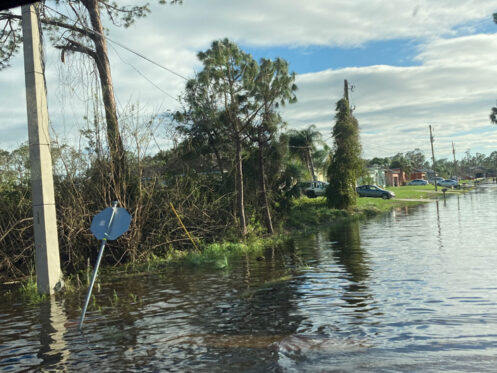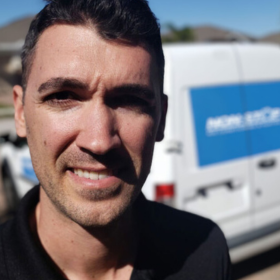After the floodwaters recede, damage to your home requires cleaning and repair. It’s also a good opportunity to assess whether your interior components, equipment, and appliances need to be restored or replaced.
Also, power surges caused by a hurricane might harm your HVAC equipment. A power surge might destroy the capacitator, compressor, wiring, and fuses of your air conditioner. Running a defective air conditioner that has been influenced by a power surge might cause a fire.
Heavy hurricane-force winds blow a lot of debris around, which can crash into your external HVAC equipment and cause damage. Wind-borne small particles can lodge in your air conditioner compressor or heat pump, impairing fin and coil efficiency. Larger debris can harm your unit’s fins and appearance, perhaps affecting interior components as well.
According to the CDC, HVAC systems may require a total repair since floods can not only erode the physical components but also serve as a breeding ground for pathogens such as bacteria and fungi. This pollution can occur in submerged areas as well as air supply ducts above the waterline. This necessitates the disinfection of all components.
While contractors strive to guarantee that the HVAC system produces a healthy indoor air when repairs are finished, it is also critical that they realize the psychological impact felt by people affected by the storm. HVAC contractors and technicians provide not just technical competence but also recommendations on whether to repair or replace—advice that may be especially useful given the plethora of options and issues their customers face in the aftermath of a tragedy.
Step 1: Take Adequate Precautions
Turn the system off. Use temporary walls, plastic sheeting, or other vapor-retarding barriers and maintain negative pressure (compared to adjacent non-construction areas) to prevent contamination from migrating to other areas or throughout the house if sections of the structure will be inhabited during repairs.
Step 2: Remove Flood-contaminated Materials from the System.
Any insulation near HVAC system components, as well as HVAC filter media polluted by floods, must be removed and disposed of in accordance with relevant Federal, State, and local standards. If any HVAC system components are polluted and cannot be successfully cleaned and disinfected, replace them with new ones.
Examine the system (indoor and outdoor units), refrigerant or gas lines, electric wiring, and any other connections for physical damage. According to the Air-Conditioning, Heating, and Refrigeration Institute, if either the interior or outdoor unit of the HVAC system has to be changed and is rated less than 13 SEER, both components must be replaced (AHRI). Indoor and outdoor units that are not correctly matched might raise the danger of early failure while decreasing efficiency.
Step 3: Clean and Disinfect Component Surfaces.
To clean the surfaces, use a HEPA-filtered vacuum cleaner to remove dirt, debris, and germs, including filter racks, drain pans, bends, and horizontal parts of air ducts where material might gather. Remove and service (clean, disinfect, completely dry, and test) the HVAC system fan before reinstalling it. Use a steam or high-pressure washer for severely soiled components. To avoid carbon monoxide dangers, use gasoline-powered pressure washers outdoors and away from air intakes.
Then, rinse with clean water after disinfecting with a bleach solution (1 cup of household chlorine bleach to one gallon of water).
Step 4: Replace the Insulation.
Replace the insulation once the HVAC system components have been cleaned and/or replaced as needed. According to the CDC, using smooth-surfaced external (not in the air stream) insulation will help prevent debris and microorganisms from collecting in the future, while upgrading to the highest efficiency filters possible is the most cost-effective way to improve the long-term quality of the indoor environment.
Step 5: Test the Hvac System and Regularly Check Performance and Condition.
Verify that all electrical components are working properly and that the HVAC system performance conforms to the recommendations in ASHRAE Standard 62.1-2016, Ventilation for Acceptable Indoor Air Quality or Standard 62.2-2016, Ventilation and Acceptable Indoor Air Quality in Low-Rise Residential Buildings. Operate the system continuously at a comfortable temperature for 48 to 72 hours, checking for objectionable flood-related odors. If present, continue the flush-out process until odors are gone, then replace the HVAC filters with new ones prior to building occupancy.
Trust Our Team For Your HVAC Needs
Non Stop Air provides the entire Charlotte county, Lee county, and Collier county area of the southwest Florida with whole home air conditioning, heating, and air purification services, specializing in residential repairs, installations and maintenance. We provide emergency, 24 hour, same day service, for all air conditioning and heating issues.
Our dedication to great customer care includes everything from written estimates to prompt project completion. Along the way, we’ll provide high-quality parts and workmanship for all major HVAC brands, available financing, and fully licensed and insured contractors.
Call Non-Stop Air Conditioning & Heating at (239) 522-8642 or message us to schedule HVAC inspection.


